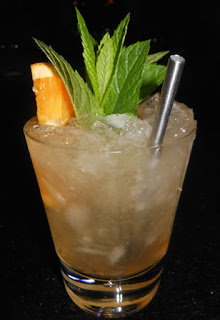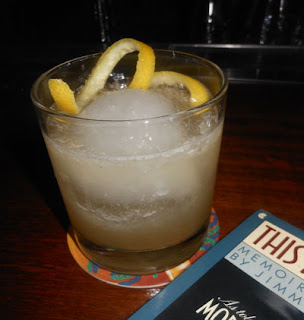3/4 oz Aperol
1/2 oz Elderflower Liqueur (St. Elder)
3/4 oz Lemon Juice
1 Egg White
Shake once without ice and once with ice. Strain into a Collins glass, top with tonic water (~3 oz), and add a straw.

quality versus quantity does not have to be a winner-take-all proposition.









 1 oz Cynar
1 oz Cynar
Arthur Avenue
• 1 1/4 oz Old Overholt Rye Whiskey
• 1 1/4 oz Aperol
• 3/4 oz Punt e Mes
• 3/4 oz Grapefruit Juice
• 1 dash Angostura Bitters
Shake with ice and strain into a cocktail glass. Twist a grapefruit peel over the top.


 The theme for this month's Mixology Monday (MxMo LXXXI) was picked by Joel of the Southern Ash blog. The theme he chose was "Highballs" which is perfect for when the winter doldrums get you down, and you have just enough energy for combining a spirit and a mixer. Joel elaborated on the concept by describing, "For this month's theme, I thought we could strip away the complexities of cocktails and relax with a nice highball… Most cocktails are at least three ingredients with the highball relegated to emergency or last resort status, but in those highballs we will seek refuge. The end of the day is sometimes better served by a simple liquor plus mixer combination than an artfully measured Corpse Reviver No. 2 This month, tell us what you'll do with a liquor and a mixer (with maybe a wee bit of garnish) to ease into the new year."
The theme for this month's Mixology Monday (MxMo LXXXI) was picked by Joel of the Southern Ash blog. The theme he chose was "Highballs" which is perfect for when the winter doldrums get you down, and you have just enough energy for combining a spirit and a mixer. Joel elaborated on the concept by describing, "For this month's theme, I thought we could strip away the complexities of cocktails and relax with a nice highball… Most cocktails are at least three ingredients with the highball relegated to emergency or last resort status, but in those highballs we will seek refuge. The end of the day is sometimes better served by a simple liquor plus mixer combination than an artfully measured Corpse Reviver No. 2 This month, tell us what you'll do with a liquor and a mixer (with maybe a wee bit of garnish) to ease into the new year."Fernet Branca and Moxie Original ElixirOnce assembled, the orange twist filled the air with a bright aroma that belied the taste to follow. A dark, caramel sip led into a beautiful combination of gentian and menthol herbalness on the swallow. Indeed, the two components worked well to balance the other out.
• 1 1/2 oz Fernet Branca
• 3 - 6 oz Moxie Original Elixir
Fill a Collins glass with ice cubes. Add Fernet Branca and top with Moxie soda. Gently stir and garnish with an orange slice (I did an orange twist instead).

Improved Toxic MoxieWhile the recipe has too many ingredients to classify as a two part Highball as per the theme, I had already cracked open a liter bottle of Moxie and decided to go to town and make better use of it. The addition of the Fee's Whiskey Barrel Bitters in this second recipe contributed a cinnamon aroma to that of the citrus oils from the orange twist. Moreover, the rye added a malt component to caramel sip and a whiskey barrel component to the otherwise complex herbal swallow. In addition, the bitters returned by donating a cinnamon finish. Overall, the Improved Toxic Moxie came across as more balanced than Fernet and Moxie alone due to being less herbally driven.
• 1 1/2 oz Rittenhouse 100 Rye
• 3/4 oz Fernet Branca
• 3 dash Fee's Whiskey Barrel Bitters
• ~4 oz Moxie Original Elixir
Fill a Collins glass with ice cubes. Add ingredients and top with Moxie soda. Gently stir and garnish with an orange twist.



Dessert L'Italienne (early version)When made with the newer, more complex recipe, the Dessert L'Italienne provided a pleasing menthol and camphor herbal aroma that shifted towards a more coffee-driven one over time. The amari's caramel flavors joined that of the espresso's roast notes on the sip, and the swallow was a complex herbal medley that ended with a coffee finish.
• 2 oz Santa Maria al Monte
• 1 oz Carpano Antica Sweet Vermouth
• 2 barspoon Galliano
Stir with ice and strain into a wine glass. Garnish with a lemon twist.



















 The 2017 collection of 855 drink recipes, bartender tributes, and essays on hospitality from CocktailVirgin's Frederic Yarm. Available at Barnes and Noble and Amazon.
The 2017 collection of 855 drink recipes, bartender tributes, and essays on hospitality from CocktailVirgin's Frederic Yarm. Available at Barnes and Noble and Amazon. The 2012 collection of 505 drink recipes, techniques, and Boston bar recommendations from Frederic Yarm. Available at Amazon and Barnes and Noble.
The 2012 collection of 505 drink recipes, techniques, and Boston bar recommendations from Frederic Yarm. Available at Amazon and Barnes and Noble.